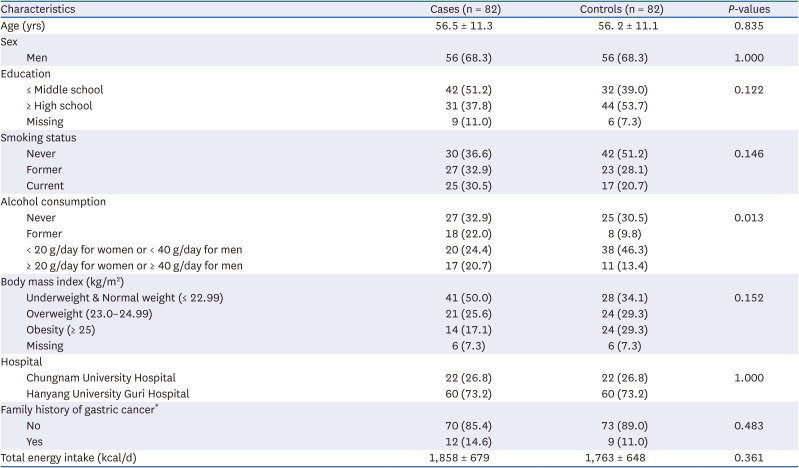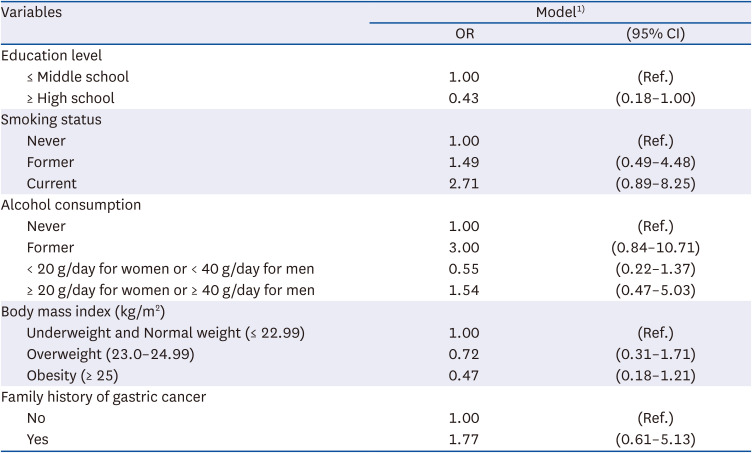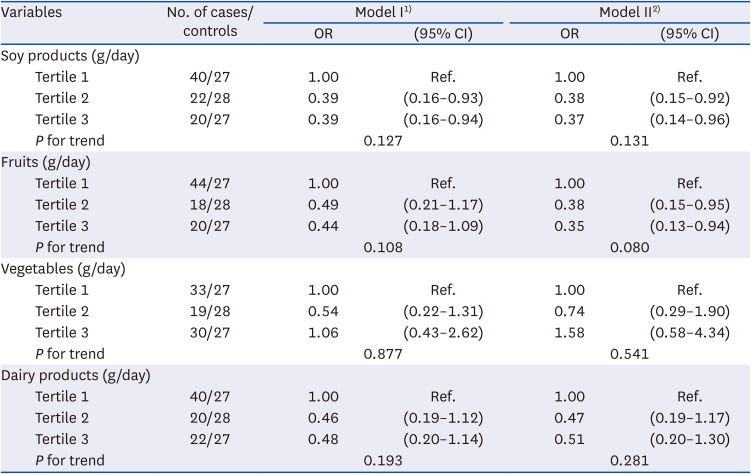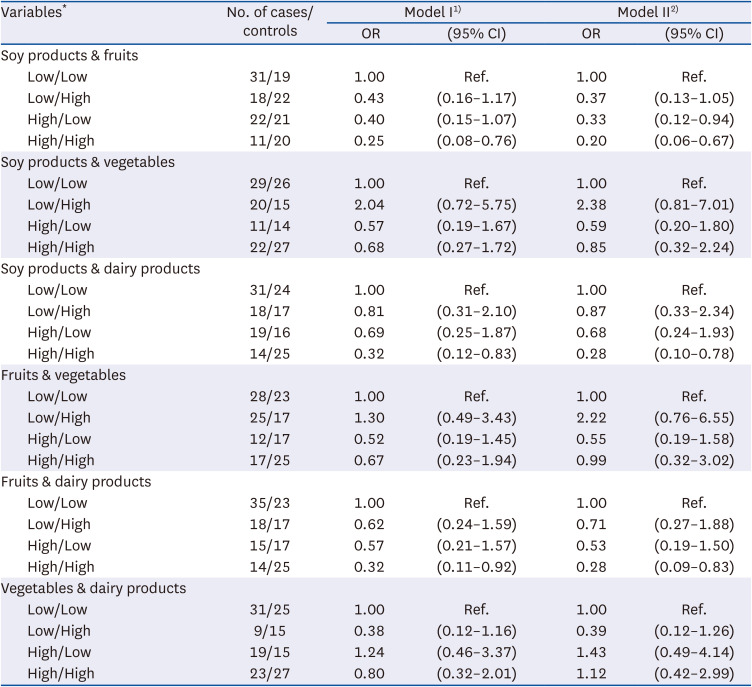1. Hardbower DM, Peek RM Jr, Wilson KT. At the bench:
Helicobacter pylori, dysregulated host responses, DNA damage, and gastric cancer. J Leukoc Biol. 2014; 96:201–212. PMID:
24868089.
2. Wang F, Meng W, Wang B, Qiao L.
Helicobacter pylori-induced gastric inflammation and gastric cancer. Cancer Lett. 2014; 345:196–202. PMID:
23981572.
3. Lim SH, Kim N, Kwon JW, Kim SE, Baik GH, Lee JY, Park KS, Shin JE, Song HJ, Myung DS, et al. Trends in the seroprevalence of
Helicobacter pylori infection and its putative eradication rate over 18 years in Korea: a cross-sectional nationwide multicenter study. PLoS One. 2018; 13:e0204762. PMID:
30332428.

4. Huang JQ, Sridhar S, Chen Y, Hunt RH. Meta-analysis of the relationship between
Helicobacter pylori seropositivity and gastric cancer. Gastroenterology. 1998; 114:1169–1179. PMID:
9609753.

5. Eslick GD, Lim LL, Byles JE, Xia HH, Talley NJ. Association of
Helicobacter pylori infection with gastric carcinoma: a meta-analysis. Am J Gastroenterol. 1999; 94:2373–2379. PMID:
10483994.
6. Khatoon J, Rai RP, Prasad KN. Role of
Helicobacter pylori in gastric cancer: Updates. World J Gastrointest Oncol. 2016; 8:147–158. PMID:
26909129.
8. Zaidi SF, Ahmed K, Saeed SA, Khan U, Sugiyama T. Can diet modulate
Helicobacter pylori-associated gastric pathogenesis? An evidence-based analysis. Nutr Cancer. 2017; 69:979–989. PMID:
28937799.

9. Montani A, Sasazuki S, Inoue M, Higuchi K, Arakawa T, Tsugane S. Food/nutrient intake and risk of atrophic gastritis among the
Helicobacter pylori-infected population of northeastern Japan. Cancer Sci. 2003; 94:372–377. PMID:
12824907.

10. Park YH, Kim N. Review of atrophic gastritis and intestinal metaplasia as a premalignant lesion of gastric cancer. J Cancer Prev. 2015; 20:25–40. PMID:
25853101.

11. Lee SA, Kang D, Shim KN, Choe JW, Hong WS, Choi H. Effect of diet and
Helicobacter pylori infection to the risk of early gastric cancer. J Epidemiol. 2003; 13:162–168. PMID:
12749604.
12. Cover TL, Peek RM Jr. Diet, microbial virulence, and
Helicobacter pylori-induced gastric cancer. Gut Microbes. 2013; 4:482–493. PMID:
23989802.
13. Gaddy JA, Radin JN, Loh JT, Zhang F, Washington MK, Peek RM Jr, Algood HM, Cover TL. High dietary salt intake exacerbates
Helicobacter pylori-induced gastric carcinogenesis. Infect Immun. 2013; 81:2258–2267. PMID:
23569116.

14. Wang T, Cai H, Sasazuki S, Tsugane S, Zheng W, Cho ER, Jee SH, Michel A, Pawlita M, Xiang YB, et al. Fruit and vegetable consumption,
Helicobacter pylori antibodies, and gastric cancer risk: a pooled analysis of prospective studies in China, Japan, and Korea. Int J Cancer. 2017; 140:591–599. PMID:
27759938.

15. Kim HJ, Lim SY, Lee JS, Park S, Shin A, Choi BY, Shimazu T, Inoue M, Tsugane S, Kim J. Fresh and pickled vegetable consumption and gastric cancer in Japanese and Korean populations: a meta-analysis of observational studies. Cancer Sci. 2010; 101:508–516. PMID:
19860848.

16. Ko KP, Park SK, Yang JJ, Ma SH, Gwack J, Shin A, Kim Y, Kang D, Chang SH, Shin HR, et al. Intake of soy products and other foods and gastric cancer risk: a prospective study. J Epidemiol. 2013; 23:337–343. PMID:
23812102.

17. Guo Y, Shan Z, Ren H, Chen W. Dairy consumption and gastric cancer risk: a meta-analysis of epidemiological studies. Nutr Cancer. 2015; 67:555–568. PMID:
25923921.

18. Lu D, Pan C, Ye C, Duan H, Xu F, Yin L, Tian W, Zhang S. Meta-analysis of soy consumption and gastrointestinal cancer risk. Sci Rep. 2017; 7:4048. PMID:
28642459.

19. Keenan JI, Salm N, Hampton MB, Wallace AJ. Individual and combined effects of foods on
Helicobacter pylori growth. Phytother Res. 2010; 24:1229–1233. PMID:
20658571.

20. Pan WH, Yeh WT. How to define obesity? Evidence-based multiple action points for public awareness, screening, and treatment: an extension of Asian-Pacific recommendations. Asia Pac J Clin Nutr. 2008; 17:370–374. PMID:
18818155.
21. Kwak JH, Eun CS, Han DS, Kim YS, Song KS, Choi BY, Kim HJ. Gastric cancer and the daily intake of the major dish groups contributing to sodium intake: a case-control study in Korea. Nutrients. 2021; 13:1365. PMID:
33921757.
22. Kim HJ, Chang WK, Kim MK, Lee SS, Choi BY. Dietary factors and gastric cancer in Korea: a case-control study. Int J Cancer. 2002; 97:531–535. PMID:
11802218.

23. The Koeran Nutrition Society. Foods and Nutrients Database of Computer Aided Nutritional Analysis Program, Version 2.0. Seoul: The Korean Nutrition Information Center;2003.
24. Yamaguchi N, Kakizoe T. Synergistic interaction between
Helicobacter pylori gastritis and diet in gastric cancer. Lancet Oncol. 2001; 2:88–94. PMID:
11905800.

25. Pudenz M, Roth K, Gerhauser C. Impact of soy isoflavones on the epigenome in cancer prevention. Nutrients. 2014; 6:4218–4272. PMID:
25322458.

26. Wang XQ, Yan H, Terry PD, Wang JS, Cheng L, Wu WA, Hu SK. Interaction between dietary factors and
Helicobacter pylori infection in noncardia gastric cancer: a population-based case-control study in China. J Am Coll Nutr. 2012; 31:375–384. PMID:
23529995.
27. Siriviriyakul P, Werawatganon D, Phetnoo N, Somanawat K, Chatsuwan T, Klaikeaw N, Chayanupatkul M. Genistein attenuated gastric inflammation and apoptosis in
Helicobacter pylori-induced gastropathy in rats. BMC Gastroenterol. 2020; 20:410. PMID:
33297977.
28. Huang W, Wan C, Luo Q, Huang Z, Luo Q. Genistein-inhibited cancer stem cell-like properties and reduced chemoresistance of gastric cancer. Int J Mol Sci. 2014; 15:3432–3443. PMID:
24573253.
29. Tse G, Eslick GD. Soy and isoflavone consumption and risk of gastrointestinal cancer: a systematic review and meta-analysis. Eur J Nutr. 2016; 55:63–73. PMID:
25547973.
30. Yang S, Park Y, Lee J, Choi IJ, Kim YW, Ryu KW, Sung J, Kim J. Effects of soy product intake and interleukin genetic polymorphisms on early gastric cancer risk in Korea: a case-control study. Cancer Res Treat. 2017; 49:1044–1056. PMID:
28111424.
31. Wu AH, Yang D, Pike MC. A meta-analysis of soyfoods and risk of stomach cancer: the problem of potential confounders. Cancer Epidemiol Biomarkers Prev. 2000; 9:1051–1058. PMID:
11045787.
32. Poorolajal J, Moradi L, Mohammadi Y, Cheraghi Z, Gohari-Ensaf F. Risk factors for stomach cancer: a systematic review and meta-analysis. Epidemiol Health. 2020; 42:e2020004. PMID:
32023777.
33. Slavin JL, Lloyd B. Health benefits of fruits and vegetables. Adv Nutr. 2012; 3:506–516. PMID:
22797986.
34. Kim DS, Lee MS, Kim YS, Kim DH, Bae JM, Shin MH, Ahn YO. Effect modification by vitamin C on the relation between gastric cancer and
Helicobacter pylori
. Eur J Epidemiol. 2005; 20:67–71. PMID:
15756906.
35. Jarosz M, Dzieniszewski J, Dabrowska-Ufniarz E, Wartanowicz M, Ziemlanski S. Tobacco smoking and vitamin C concentration in gastric juice in healthy subjects and patients with
Helicobacter pylori infection. Eur J Cancer Prev. 2000; 9:423–428. PMID:
11201681.
36. Zhang ZW, Patchett SE, Perrett D, Domizio P, Farthing MJ. Gastric alpha-tocopherol and beta-carotene concentrations in association with
Helicobacter pylori infection. Eur J Gastroenterol Hepatol. 2000; 12:497–503. PMID:
10833091.
37. Hord NG, Tang Y, Bryan NS. Food sources of nitrates and nitrites: the physiologic context for potential health benefits. Am J Clin Nutr. 2009; 90:1–10. PMID:
19439460.
38. Habermeyer M, Roth A, Guth S, Diel P, Engel KH, Epe B, Fürst P, Heinz V, Humpf HU, Joost HG, et al. Nitrate and nitrite in the diet: how to assess their benefit and risk for human health. Mol Nutr Food Res. 2015; 59:106–128. PMID:
25164923.
39. Górska-Warsewicz H, Rejman K, Laskowski W, Czeczotko M. Milk and dairy products and their nutritional contribution to the average polish diet. Nutrients. 2019; 11:1771. PMID:
31374893.
40. Wang S, Zhou M, Ji A, Zhang D, He J. Milk/dairy products consumption and gastric cancer: an update meta-analysis of epidemiological studies. Oncotarget. 2017; 9:7126–7135. PMID:
29467955.
41. Mukai T, Asasaka T, Sato E, Mori K, Matsumoto M, Ohori H. Inhibition of binding of
Helicobacter pylori to the glycolipid receptors by probiotic
Lactobacillus reuteri
. FEMS Immunol Med Microbiol. 2002; 32:105–110. PMID:
11821231.
42. Lamothe S, Azimy N, Bazinet L, Couillard C, Britten M. Interaction of green tea polyphenols with dairy matrices in a simulated gastrointestinal environment. Food Funct. 2014; 5:2621–2631. PMID:
25154916.
43. Yoon JY, Cha JM, Hong SS, Kim HK, Kwak MS, Jeon JW, Shin HP. Fermented milk containing
Lactobacillus paracasei and
Glycyrrhiza glabra has a beneficial effect in patients with
Helicobacter pylori infection: a randomized, double-blind, placebo-controlled study. Medicine (Baltimore). 2019; 98:e16601. PMID:
31464895.
44. Wu L, Wang Z, Sun G, Peng L, Lu Z, Yan B, Huang K, Yang Y. Effects of anti-
H. pylori triple therapy and a probiotic complex on intestinal microbiota in duodenal ulcer. Sci Rep. 2019; 9:12874. PMID:
31492912.
45. Yang-Ou YB, Hu Y, Zhu Y, Lu NH. The effect of antioxidants on
Helicobacter pylori eradication: a systematic review with meta-analysis. Helicobacter. 2018; 23:e12535. PMID:
30191635.
46. Ramón JM, Serra L, Cerdó C, Oromí J. Dietary factors and gastric cancer risk. A case-control study in Spain. Cancer. 1993; 71:1731–1735. PMID:
8448737.









 PDF
PDF Citation
Citation Print
Print



 XML Download
XML Download